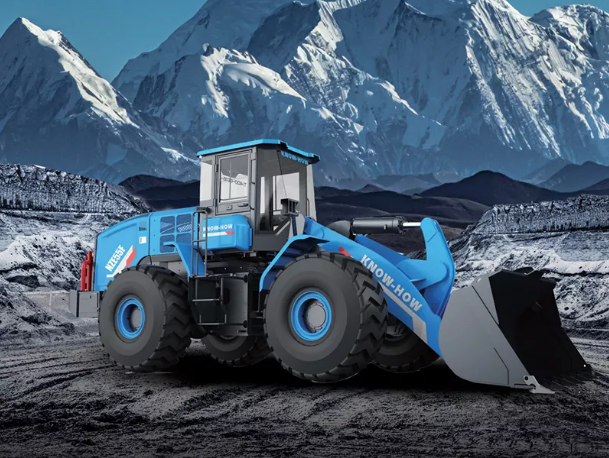What Is the Function of a Wheel Loader?
Wheel loaders, also referred to as front loaders, are robust machines extensively employed for loading various equipment or materials with the aid of a bucket. The selection of wheel loaders varies based on the specific requirements of the project. Below is a comprehensive overview to familiarize yourself with wheel loaders before procuring one for your project.
What is a wheel loader?
Wheel loaders, also known as front-end loaders, front loaders, wheeled loaders, bucket loaders, scoop loaders, or skip loaders, are heavy-duty pieces of equipment commonly found on construction sites and building projects. Employing an arm mechanism to raise and lower its bucket, and a bell crank to open and close said bucket, a wheel loader is adept at lifting a wide array of materials including debris, gravel, soil, dirt, pallets, and more. Thanks to its wheel-based design, it boasts enhanced mobility on roads while minimizing damage to asphalt or concrete surfaces. Additionally, the versatility of wheel loaders is enhanced by their compatibility with various attachments, ensuring suitability for a diverse range of project requirements.
Available in a range of sizes, wheel loaders are adaptable to projects of any scale. Even compact loaders possess formidable power, making them suitable for a multitude of tasks. With options spanning different dimensions, wheel loaders cater to the specific needs of various projects, ensuring efficiency and effectiveness.
What can a wheel loader be used for?
Wheel loaders are formidable machines renowned for their power and durability, making them indispensable on construction sites where efficiency is paramount. Equipped with an arm and bucket, they excel at hauling, scooping, and transporting large-scale materials across job sites. Beyond construction, wheel loaders find utility in agricultural operations and landscaping projects, showcasing their versatility across diverse industries.
These machines can dig, haul, carry, and transport. Wheel loaders can also be used in helping build roads, prepare job sites, and assist in cleaning up after a completed project.
Wheel loader applications
There are specific wheel loaders that are designed according to different purposes.
Block Handling
Wheel loaders utilized for block handling tasks are designed to perform heavy lifting and transporting duties consistently, even in challenging conditions such as uneven, wet, or steep terrain.
Log Handling
Applications involving log handling demand high capacity, flexibility, and a diverse array of attachments tailored for tasks like cutting and hauling.
Rock Handling
Loaders engineered for rock handling are meticulously crafted to deliver optimal performance and outcomes. With robust strength, stability, traction, and durability, these loaders are purpose-built to thrive in hot and dusty environments.
Related links:
What is the Best Diesel Driven Portable Screw Air-compressor Solution?
Maximize Efficiency: 5 Must-Know Tips for Animal Feed Plants
The Advantages of Implementing Solar Energy Solutions
Steam Boilers Compared: Fire-Tube vs. Water-Tube Explained
How Hydraulic Excavator Projects Can Transform Cities?
How Cutting Plotter Trimmers Revolutionize Window Tinting?
Waste Handling
The Advantages of Utilizing Stainless Steel Beer Tanks
Specifically designed for various tasks within waste and recycling applications, waste loaders excel in collecting, transporting, and sorting operations. Frequently deployed in landfill sites, these machines are adept at handling waste of all sizes with efficiency and ease.
Slag Handling
Typically deployed in steel mills, slag handling loaders stand out as some of the most resilient machines available. Operating in one of the most hazardous environments for both machinery and operators, they contend with extreme heat, dust, and toxic fumes. These loaders offer heat-proofing and thermal protection, ensuring the completion of projects under such challenging conditions.
Rehandling
Engineered for maximum productivity, these loaders excel in transporting substantial volumes of materials, thereby minimizing loading cycles. Their efficiency significantly streamlines project timelines, making them a convenient and time-saving solution for various projects.
Agriculture
Delivering continuous performance, these loaders are capable of working tirelessly throughout the day. Suitable for both indoor and outdoor use, agriculture loaders efficiently transport diverse loads across farms, even in the harshest weather and ground conditions.
How can I choose the right size of wheel loader?
Selecting the appropriate wheel loader size is crucial for optimizing project efficiency. With various sizes and attachments available, it's essential to make a well-informed choice. Begin by assessing the nature of the job and the characteristics of the project site.
When choosing a wheel loader, factors such as the size of the project site, bucket capacity, and reach of the loader's arm are key considerations. Consulting with the manufacturer can provide valuable insights into which type and size of equipment will maximize productivity and efficiency for the specific project requirements.
Wheel loader sizes
Small/Compact Loaders: These loaders, ranging from 1 to 4.5 tons operating or work load, are favored by landscaping companies for tasks such as digging and material relocation. Their versatility shines when paired with attachments like forks and rakes, making them ideal for yard projects.
Mid-Sized Loaders: Falling within the range of 5.5 to 6.5 tons operating or work load, mid-sized loaders excel in moving larger and heavier materials. They are commonly found on construction sites due to their capability to handle substantial loads.
Large Loaders: Ranging from 7.5 to 18 tons operating or work load, large loaders are primarily utilized for loading trucks with gravel and tackling heavy-duty projects that demand significant lifting capacity.
Before purchasing a wheel loader, it's essential to grasp these fundamental aspects. When shopping for a wheel loader, you'll encounter a plethora of manufacturers and models. Many manufacturers offer compact, medium, and large wheel loaders to cater to diverse needs and preferences.
Related links:How to Optimize Livestock Feed Processing Systems Efficiently
How Livestock Feed Processing Systems Improve Efficiency?
How Does Advanced Solar Panel Technology Work?
Electric Hot Oil Boiler vs. Traditional Boilers: Key Differences Explained
How Should We Rethink 1 BBL Brewhouse?
5-in-1 Laser Cutting Air Compressor: Compare and Choose Wisely!
How to Choose the Best Fermentation Tanks?












